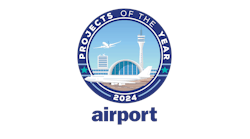In the current state of the world, we are hyper-aware of where we are going and whom we are encountering along the way. The interactions of our daily journeys are significantly impacted, causing us to rethink our safety measures and question precautions taken by others.
This is especially true when traveling through airports. With passengers arriving, departing and connecting from numerous locations around the globe, is it difficult to know who is following guidelines before and throughout their travels, making the choice to fly seem inherently riskier.
Airports and airlines around the world are doing their best to entice passengers back with flight discounts and enhanced safety protocols, albeit with limited success. The number of scheduled worldwide flights has significantly decreased by 46.3 percent compared to flights scheduled around the same time last year, according to statista.com. It is clear that a chief concern of flyers and their travel experience are the myriad of touchpoints within the airport and the perceived risk of being exposed to COVID-19.
For airports, it’s important to focus on the passenger experience and how every step and touchpoint of the journey makes them feel. Managing passengers’ concerns has never been more significant. In recent months, Populous commissioned a proprietary Qualtrics survey that collected data on American passengers’ perceptions and worries. Populous translated the data into touchpoint design solutions airports can implement now with minimal expense. These design solutions have the potential to ease travelers’ anxieties and guide the aviation industry along the road to recovery.
Simplifying Pick-up and Drop-Off
According to our Qualtrics data, nearly 90 percent of surveyed passengers prefer transportation options that limit contact with others as we’ve seen rides from family members, self-driving, rental cars, and carpooling increase since the pandemic. With more family and friends doing pick-ups and drop-offs as passengers avoid public transportation, the curbside needs to better support unfamiliar drivers. A structured curbshare concept provides a clear path for drivers and a dedicated waiting area for passengers. Highly visible color-coded and numbered beacons provide unmistakable pickup locations so that passengers and drivers can easily find each other.
Streamlined Security
The majority of travelers are concerned about maintaining social distancing with others and interactions with TSA and airline agents while checking-in and passing through security. Off-site solutions can reimagine the check-in and security process entirely for a more streamlined and pleasant passenger experience. These external screening solutions reduce passenger wait time by letting them clear through security before even reaching the airport. A secure entry would connect directly to the post-security area of the terminal. This increased space also allows for a staging area post-security, where passengers can wait for companions and organize carry-on items after TSA screening.
The use of off-site access points, particularly when designed around large-scale events, offers a smoother overall experience that bypasses stress-inducing security lines and creates a positive final impression before visitors leave the event destination. These controlled spaces also provide an opportunity for events and cities to create one cohesive journey from hotel to plane. New opportunities for branding and sponsorships are created as a result. It’s exactly this sort of VIP experience airports should have in mind when 59 percent of our surveyed passengers say they would feel safer with off-site security and of those, 77 percent say they’re likely to pay more for it.
App-based Technologies
Whether its security checkpoints, food and beverage, or waiting for a flight in the terminal, the ultimate way to transform the airport into a touchless experience is to incorporate innovative app-based technologies at each touchpoint. The more control the passenger has over their experience ultimately impacts the trust and confidence they will have in traveling through the airport. More than 80 percent of passengers are willing to use a phone app for a timed airport experience.
Taking cues from theme parks, airports can limit capacity in security screening with timed entry and virtual queuing. Passengers are notified via the airport’s app as to when they should arrive at the airport, and which entry and security line to use. Digital signage will announce which group is currently being welcomed to security. Using a phone app for a timed airport experience manages crowds and increases communications the airport has with each of its passengers.
Innovative Food and Beverage Options
How can we re-think traditional airport concession spaces to be safer and more convenient? With 24 percent of passengers surveyed opting to bring their own food, coming up with a food court solution that accommodates these new preferences should establish trust and eliminate many uncertainties of the dining experience.
Airports and food courts might implement an array of self-contained seating modules/pods for dining, which can be configured to accommodate families, groups and individual travelers alike. These modules allow space for luggage and offer self-dispensing utensils and condiments, as well as sanitizing stations.
Grab and Go is another popular option. We’ve been seeing design concepts similar to this in the sports industry, where arenas and venues are adding prefabricated locker systems to existing concession countertops and converting select food and beverage stands to Grab and Go for contactless pick-up options. These locker systems can be easily sanitized after each use and will work well in an airport setting.
Location markers can also be added to existing tables and seating areas so travelers can have food and beverage delivered to them via in-app ordering wherever they are in the airport. A reported 70 percent of passengers would prefer to use an app to order food and beverage items. This method permits travelers to spend more time relaxing and dining, and less time waiting in lines or directly interacting with staff at the point of sale locations.
Clear Communications
While these design solutions are helpful, at the end of the day, one of the most important changes airports and airlines can make to ensure passenger comfort is clear and consistent communication. More than 80 percent of passengers would feel safer if they had clear instructions before arriving at the airport, and saw clear signage specifying how the airport is reducing the spread of the virus. It is vital for airports and airlines to invest in signage, wayfinding and other communication tools to set expectations for safety protocols, rules and regulations.
The time for airports to make an impactful change is now. With our research and innovative design team, we believe we have design solutions that address the immediate concerns of today’s passengers while also eliminating huge upfront expenses to the airports. As the climate on safety protocols develop over time, we will continue to work on longer-term solutions around experience design and safety as permanent solutions to keep passengers safe, informed, and comfortable with flying again post-COVID.
Geoffrey Ax is Populous Americas Aviation Market Leader and Principal. He has more than 20 years of leadership experience in the project, executive, client management and business development phases for major airport projects with budgets in excess of US$1bn. He has led the small- and large-scope design of terminals, operations, cargo facilities, and more, including the Metropolitan Washington Airports Authority, Los Angeles World Airports, and Jorge Chávez International Airport in Lima, Peru.






